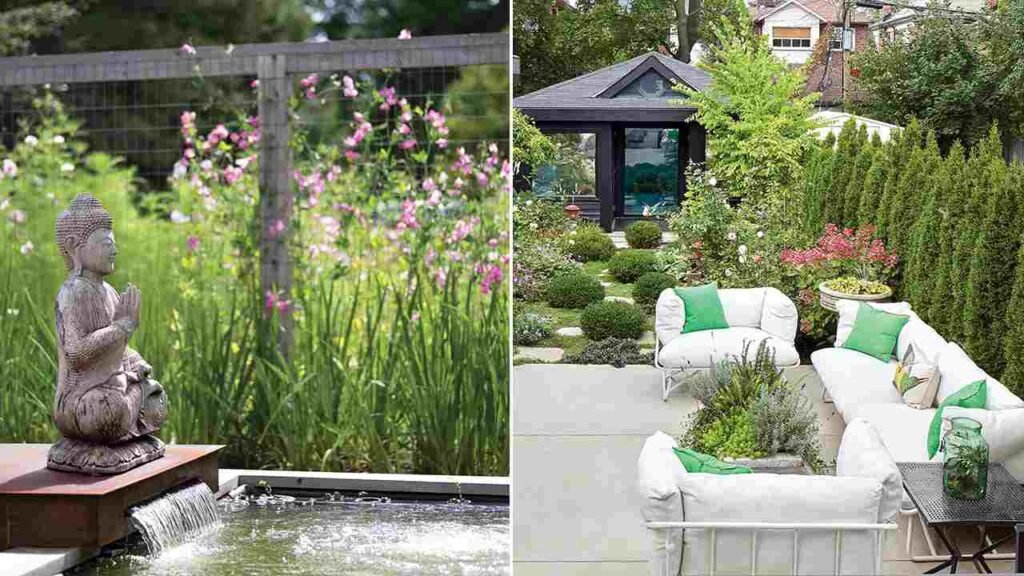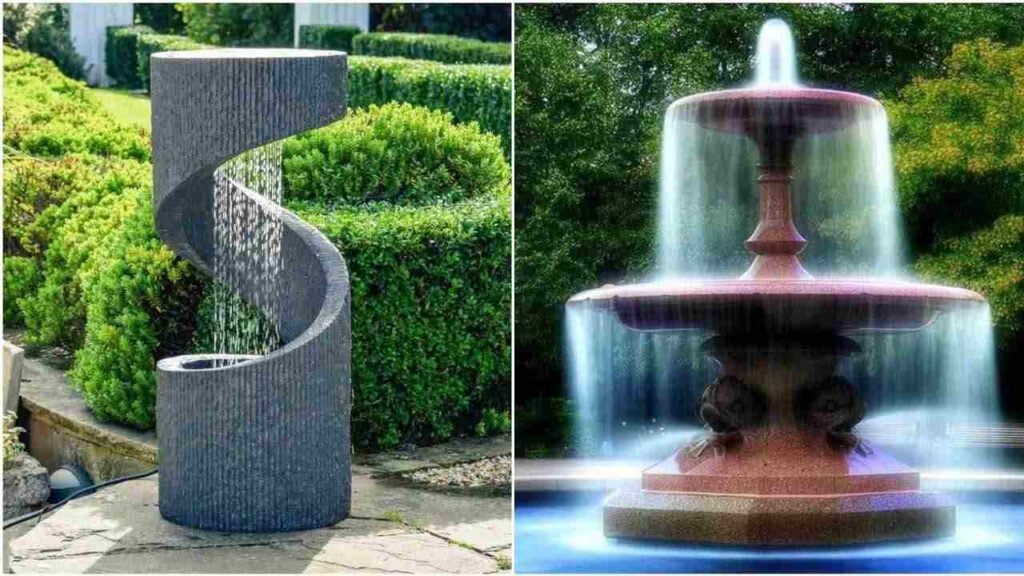Adding a water feature to your hardscape design can transform your outdoor space into a serene oasis. Whether it’s a bubbling fountain, a tranquil pond, or a sleek water wall, the sound of flowing water can create a calming atmosphere that enhances your overall landscaping. Water features not only add visual interest but also attract wildlife, making your garden feel more alive. They can serve as focal points, drawing the eye and creating a sense of harmony within your hardscaped areas. In this guide, supported with Evergreen Landscaping of Cincinnati, we will explore various types of water features, the benefits they offer, and essential considerations for integrating them into your hardscape design seamlessly.

Before diving in, it’s essential to consider factors like size, style, and location to ensure the water feature complements your existing hardscaping services and meets your maintenance preferences. With careful planning, a water feature can elevate your hardscape and create a beautiful retreat right at home. Additionally, think about the sound level you desire, as some features can be quite loud, while others offer a gentle trickle. Lastly, ensure you have access to water and electricity if needed, as these are crucial for functionality and maintenance.
Benefits of Adding a Water Feature to Hardscapes
Adding a water feature to your hardscape design offers numerous benefits that enhance both aesthetics and functionality. Water features create a calming ambiance, as the sound of flowing water can drown out unwanted noise from traffic or neighbors, providing a tranquil retreat. They serve as stunning focal points in your outdoor space, drawing attention and creating a visual centerpiece. Moreover, water features can attract wildlife, such as birds and butterflies, enriching your garden’s ecosystem. They also help regulate the microclimate, offering cooler air during hot summer days. Finding inspiration in nature, you can design a water feature that harmonizes with your landscape, integrating elements like stones, plants, and natural materials to create a cohesive look.
Popular Types of Water Features for Hardscape Designs
When it comes to incorporating water features into hardscape designs, several popular options can complement your outdoor space. Fountains are a classic choice, available in various styles, from traditional tiered designs to modern minimalist structures, providing both beauty and soothing sounds. Ponds can create a natural focal point, especially when surrounded by lush landscaping, offering a habitat for fish and aquatic plants. Water walls, which feature cascading water over a vertical surface, provide a contemporary look while saving space. Birdbaths not only attract feathered friends but also add charm to your garden. Balancing aesthetics and functionality is essential when selecting a water feature, as it ensures that your design not only enhances the visual appeal of your hardscape but also serves a practical purpose, such as providing wildlife habitats or cooling the surrounding air.
Choosing the Right Location for Your Water Feature
Selecting the right location for your water feature is crucial for its overall success and enjoyment. Consider visibility; placing your water feature where it can be easily seen from indoor living spaces, such as a patio or living room, allows you to enjoy its beauty regularly. Additionally, think about accessibility for maintenance; ensure you can reach the feature without obstruction. Proximity to existing plants can enhance the natural look, but avoid placing it too close to trees, as roots may interfere with the water feature over time. Sunlight exposure is also vital; some water features thrive in full sun, while others prefer shade. Finally, consider how the location affects the flow of water and sound to create the desired ambiance.
Size Considerations for Water Features in Hardscaping
When adding a water feature to your hardscape, size is an essential consideration that impacts both aesthetics and functionality. The scale of the water feature should complement your existing landscape and hardscape elements to ensure a cohesive look. A large pond may overwhelm a small yard, while a tiny fountain might get lost in a spacious garden. Additionally, think about the feature’s depth; deeper ponds can support aquatic life but require more maintenance, while shallow features may be easier to care for but less accommodating for fish. Be mindful of your budget as well; larger installations generally incur higher costs for materials and maintenance. Ultimately, balance is key—choose a size that enhances your outdoor space without overpowering it.
Integrating Water Features with Existing Hardscape Elements
Seamlessly integrating a water feature with existing hardscape elements can enhance the overall design of your outdoor space. Consider how the water feature complements other hardscape components like patios, walkways, and retaining walls. For instance, aligning the edge of a pond with a patio can create a unified look and encourage natural flow between different areas. Use materials that match or complement existing surfaces, such as stone, brick, or concrete, to ensure visual harmony. Additionally, landscaping around the water feature can further blend it into the environment; choose plants that thrive near water while providing color and texture. Thoughtful integration not only creates an appealing aesthetic but also enhances the functionality of your outdoor living area.
Maintenance Tips for Water Features in Hardscapes
Proper maintenance is essential for keeping your water feature looking beautiful and functioning effectively. Regular cleaning is vital to prevent algae buildup and debris accumulation, which can detract from the aesthetic appeal and water quality. Use a skimmer or net to remove leaves and organic matter, and consider using a pond vacuum for deeper cleaning. It’s also important to monitor water levels and replenish evaporated water, especially in hot weather. If your feature includes fish, maintain the appropriate water conditions and check for any signs of disease. Additionally, inspect pumps and filters regularly to ensure they are operating efficiently. Following these maintenance tips will ensure that your water feature remains a vibrant and inviting element of your hardscape design.
The Role of Water Features in Attracting Wildlife
Water features play a significant role in attracting various forms of wildlife, making your garden a lively ecosystem. Birds are often drawn to the sound of flowing water, using it as a drinking source or bathing spot. Including shallow areas in ponds or birdbaths can enhance their appeal, providing safe access for smaller birds. Butterflies and bees are attracted to the moisture around water features, benefiting your garden’s pollination efforts. Additionally, ponds can support fish and amphibians, creating a balanced aquatic environment that promotes biodiversity. To further enhance wildlife attraction, incorporate native plants around your water feature, providing natural habitats and food sources. By creating a welcoming environment, your water feature can transform your garden into a thriving sanctuary for various creatures.
Design Styles for Water Features in Hardscaping
When incorporating water features into your hardscape, various design styles can enhance the overall aesthetic of your outdoor space. A contemporary design may include sleek, minimalist features like water walls or geometric fountains, perfect for modern homes. For a more traditional look, consider classic elements like tiered fountains or ornamental ponds with lily pads. Naturalistic designs, featuring boulders and native plants, can create a tranquil setting that mimics a woodland stream or a mountain spring. Rustic styles often incorporate wooden elements, such as a water wheel or barrel fountain, blending beautifully with a country or farmhouse aesthetic. Whatever your design preference, choosing a style that complements your existing hardscape and landscaping will create a cohesive and inviting outdoor environment.

Budgeting for Your Water Feature Installation
Budgeting for your water feature installation involves considering various factors to ensure a successful project. Start by determining the type of water feature you want, as costs can vary significantly. For instance, simple birdbaths or bubbling rocks are typically more affordable than larger ponds or elaborate fountains. Factor in additional expenses, such as plumbing, electrical work, and landscaping around the feature. Installation costs can also vary depending on whether you hire professionals or tackle the project yourself. Don’t forget to include ongoing maintenance costs in your budget, such as water treatments, plants, and cleaning supplies. By carefully planning your budget, you can choose a water feature that enhances your outdoor space without breaking the bank.
Common Challenges When Adding Water Features
Adding a water feature to your hardscape design can present several challenges that homeowners should be aware of. One common issue is determining the right location; improper placement can lead to problems with visibility, accessibility, and drainage. Additionally, integrating the feature with existing hardscape elements may require careful planning to ensure visual harmony. Maintenance can also be a challenge; water features require regular upkeep to prevent issues such as algae growth and debris buildup. Furthermore, if your area experiences extreme weather, you may need to take extra precautions to protect the feature from freezing or excessive heat. By anticipating these challenges and planning accordingly, you can create a successful water feature that enhances your outdoor space.
Enhancing Outdoor Lighting Around Water Features
Proper lighting around your water feature can enhance its beauty while improving safety and ambiance. Illuminating a fountain or pond not only highlights its architectural elements but also creates a magical atmosphere during evening hours. Consider using submersible lights for ponds or LED fixtures around fountains to create a stunning visual effect. Solar-powered lights are a great eco-friendly option, offering convenience without the need for wiring. You can also use path lights to illuminate walkways leading to your water feature, ensuring safe navigation in low-light conditions. Additionally, accent lighting can highlight surrounding plants and hardscape elements, drawing attention to the entire area.
Conclusion
Incorporating a water feature into your hardscape design can significantly enhance the beauty and tranquility of your outdoor space. From calming fountains to serene ponds, water features offer a unique way to create a peaceful atmosphere while attracting wildlife and improving your garden’s ecosystem. By carefully considering factors such as size, location, and design style, you can select the perfect feature that complements your existing landscape. Additionally, addressing maintenance needs and budgeting effectively ensures long-term enjoyment of your investment. With thoughtful planning and execution, a water feature can become a stunning focal point in your hardscape, providing relaxation and visual interest for years to come, ultimately transforming your yard into a personal oasis.
FAQs
What types of water features can I add to my hardscape design?
You can choose from various options, including fountains, ponds, waterfalls, and water walls. Each type offers unique aesthetics and ambiance, allowing you to customize your outdoor space.
2. How do I determine the right size for a water feature?
The size should be proportional to your outdoor area and the surrounding landscaping. Consider both the space available and how the feature will fit into the overall design.
3. What maintenance is required for water features?
Maintenance needs vary by type but generally include cleaning, monitoring water levels, and ensuring proper filtration. Regular checks will help keep the feature looking beautiful and functioning properly.
4. Can I install a water feature myself, or should I hire a professional?
While some simple features can be DIY projects, hiring a professional is recommended for more complex installations. Professionals can ensure proper design, plumbing, and electrical work, enhancing safety and longevity.
5. Will adding a water feature increase my property value?
Yes, a well-designed water feature can enhance curb appeal and create a tranquil outdoor space, which may boost property value. It can also attract potential buyers looking for unique landscape features.
